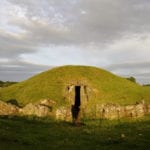 Mysteries
Mysteries  Mysteries
Mysteries  History
History 10 Surprising Stories About the Texas Rangers
 Humans
Humans 10 Philosophers Who Were Driven Mad by Their Own Theories
 Miscellaneous
Miscellaneous 10 Video-Game-Worthy Weapons and Armors from History
 Weird Stuff
Weird Stuff 10 Psychics Who Accurately Predicted Wartime Events
 The Arts
The Arts 10 Pieces of Art Inspired by a Broken Heart
 Health
Health 10 Science Fiction-Sounding New Medical Treatments
 History
History 10 Surprising Facts About the Father of Submarine Warfare
 Space
Space Ten Astonishing New Insights into Alien Worlds
 Weird Stuff
Weird Stuff 10 Bizarre Summer Solstice Rituals Still Practiced Today
 Mysteries
Mysteries Top 10 Haunting Facts About the Ghost Ship MV Alta
 History
History 10 Surprising Stories About the Texas Rangers
 Humans
Humans 10 Philosophers Who Were Driven Mad by Their Own Theories
Who's Behind Listverse?

Jamie Frater
Head Editor
Jamie founded Listverse due to an insatiable desire to share fascinating, obscure, and bizarre facts. He has been a guest speaker on numerous national radio and television stations and is a five time published author.
More About Us Miscellaneous
Miscellaneous 10 Video-Game-Worthy Weapons and Armors from History
 Weird Stuff
Weird Stuff 10 Psychics Who Accurately Predicted Wartime Events
 The Arts
The Arts 10 Pieces of Art Inspired by a Broken Heart
 Health
Health 10 Science Fiction-Sounding New Medical Treatments
 History
History 10 Surprising Facts About the Father of Submarine Warfare
 Space
Space Ten Astonishing New Insights into Alien Worlds
 Weird Stuff
Weird Stuff 10 Bizarre Summer Solstice Rituals Still Practiced Today
10 Islands With Interesting Animal Populations
Islands are notable for many different things. Some islands are popular vacation spots because of their pristine beaches, perfect surfing conditions, and beautiful snorkeling reefs. Others are known for volcanoes, awesome hiking trails, or indigenous tribes.
These 10 islands are remarkable because of their unique animal populations. Some of these creatures draw tourists from around the world, some are protected from human contact, and some you may just want to avoid.
10 Green Iguanas In Grand Cayman
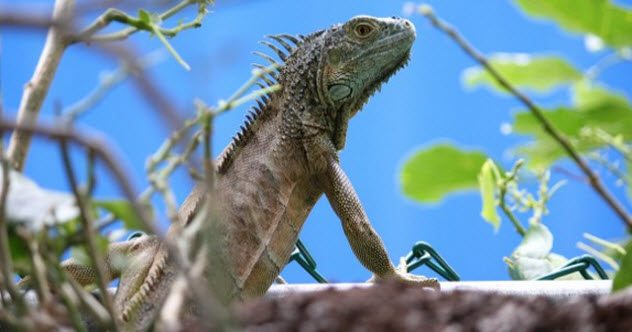
The largest of the Cayman Islands has been invaded by green iguanas. Native to Central and South America, these reptiles were introduced to the island in the 1980s. They were brought to Grand Cayman as pets and multiplied rapidly in the wild.
The green iguana is a peaceful herbivore, but it is still dangerous to the island. The large lizard poses a threat to Grand Cayman’s natural resources. They strip the bark from trees in the wild, damage gardens and farms, and compete with indigenous species for food sources. Grand Cayman has already been overrun with green iguanas, and the government fears that they will spread to Little Cayman and Cayman Brac.[1]
To protect the neighboring islands and gain some control over the situation in Grand Cayman, the Department of Environment is working to find a way to eradicate these creatures. Before 2010, it was illegal to kill iguanas in Grand Cayman, but an exception has been made for the invasive green species.
Between May 2016 and November 2017, registered hunters were paid $2 for every green iguana they killed. This removed at least 8,500 green iguanas from Grand Cayman. With the green iguana population estimated to be approaching one million, these numbers are not enough to have any real impact.
9 Christmas Island Red Crabs
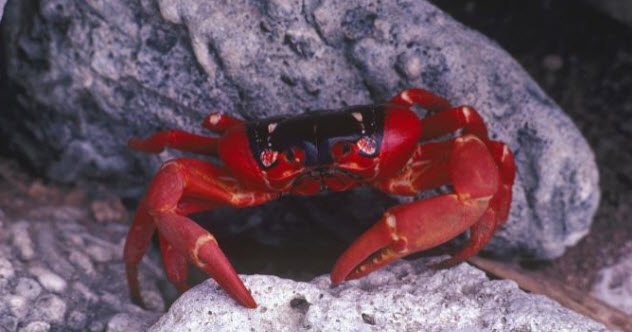
The top of an ancient volcano in the Indian Ocean, this Australian territory is famous for its bright red crustaceans. Christmas Island is home to the Christmas Island red crab, a species native to the island that cannot be found anywhere else in the world.
About 40–50 million red crabs live on Christmas Island. For most of the year, the crabs live in the rain forest, feeding on leaves and fruits that litter the rain forest floor. During the dry season, they dig burrows and retreat underground to maintain their body moisture. Wet season typically begins during October or November, which allows the crabs to leave their burrows and make their annual trek to the shores to breed.
Correlating with the Moon phases, adult males head to the beach first and dig “mating burrows.” Females follow soon after. During this time, Christmas Island is swarmed with seas of red crabs as they migrate to the shore. Along heavily trafficked routes, roads are closed and tunnels are built to provide the crabs with safe passage.
Male red crabs return to the rain forest after mating is finished. Females follow approximately two weeks later after they release their eggs into the ocean. And four weeks after that, baby crabs emerge from the water and follow in their parents’ footsteps as they make their way inland.[2]
8 Seal Island
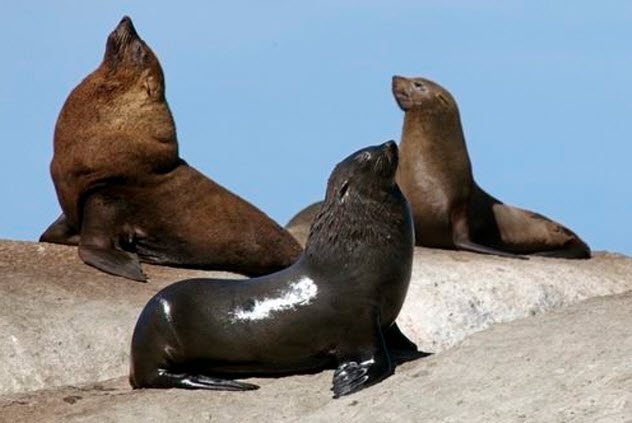
Seal Island is a reserve located in False Bay off the coast of Cape Town, South Africa. There are no sandy beaches or vegetation on the small granite landmass, but the island is covered in Cape fur seals. Their population is estimated to be around 75,000.
Seal Island is uninhabited and off-limits to tourists, but the remains of huts typically used by sealers in the early 1900s and a mangled World War II radio mast show that humans spent time on the island in the past.
Though still hunted in other countries, such as neighboring Namibia, Cape fur seals have been a protected species in South Africa since 1973.[3] But that does not mean they are safe from predators. During certain times of the year, particularly the winter months (June through August), the waters surrounding Seal Island are known as the Ring of Death. Great white sharks that feed on the seals circle the island looking for a tasty treat.
While the island itself does not permit visitors, boat tours of False Bay allow people to see the Cape fur seals sunning themselves or playing in the water. And those brave enough can cage-dive during times of high shark activity for an up-close encounter with the seal-thirsty great whites.
7 Isle Royale’s Moose And Wolves
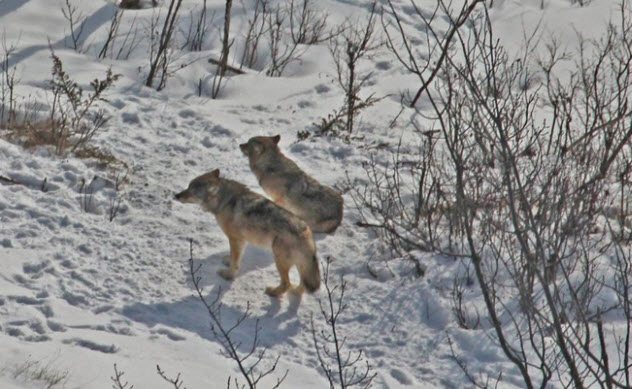
Isle Royale is the location of the longest-running predator-prey study in the world. The largest island on Lake Superior, Michigan’s Isle Royale is a national park as well as a biosphere reserve. Scientists have been observing the interactions between moose and wolves on the island since 1958.
Neither species is native to Isle Royale. It is assumed that moose swam to the island in the early 1900s, while wolves walked across the frozen lake sometime in the mid-1900s.
An estimated 1,600 moose live on Isle Royale, while the wolves that prey on them have dwindled to just two. The relatively recent lack of wolves has allowed the moose population to flourish. During the past six years, the number of moose on the island has increased annually by an average of 20 percent. Scientists are concerned that the abundance of moose will have negative effects on the island’s vegetation, especially if their numbers continue to grow at such an alarming rate.[4]
As for the wolves, about 30 of them lived on the island 10 years ago and only two remain. Their decline is attributed to extreme inbreeding. The last two wolves are father and daughter and also share the same mother. Researchers say that the two have attempted to mate at least once in the past.
A pup was observed with the pair in 2015. But the pup had visible health issues that included a deformed tail and other abnormal physical traits. The pup has not been seen since and is assumed to have died. It is unlikely that the remaining wolves can produce any viable offspring.
A proposal to introduce additional wolves to the island is still being assessed.
6 Wild Horses On Assateague Island
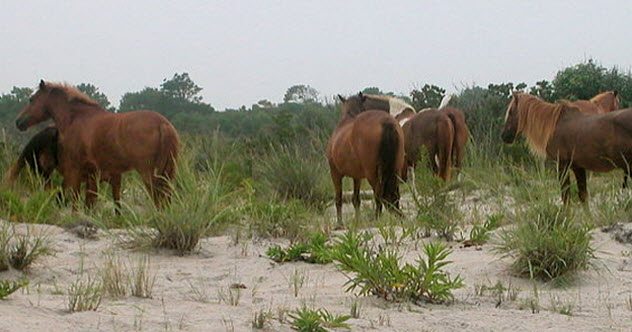
Assateague Island is home to approximately 300 wild horses. The island lies off the coasts of both Maryland and Virginia and belongs to both states. The northern two-thirds of the island is part of Maryland, and a fence separates the southern Virginia portion of the island.
The horses are split into two herds, one in each state. The Virginia herd is called the “Chincoteague ponies,” while Maryland calls their herd “Assateague’s wild horses.” The Assateague “wild” horses are technically feral horses. They descended from domesticated horses that reverted to a wild state.
Some say that the Chincoteague ponies should be called horses, not ponies, but they did in fact become a registered breed (“Chincoteague Pony”) in 1994. The average height of a horse on Assateague Island falls within the parameters of a pony rather than a horse. Their smaller build is thought to be a result of their diet, which consists mainly of marshy grasses that contain few nutrients.
Exactly how the horses came to reside on Assateague Island is not known. Local legend claims that they were survivors of a long-ago shipwreck. Fans of this theory point out the high number of shipwrecks in the area as well as the common practice of transporting horses by boat. Others believe that the horses were brought to Assateague Island in the late 1600s from the mainland by owners looking to avoid fencing laws and livestock taxation.[5]
The horses on the island are a popular attraction, but it is important to remember that they are not domestic pets. Every year, visitors who get too close to the horses end up getting kicked or bitten.
5 Henderson Island Rats
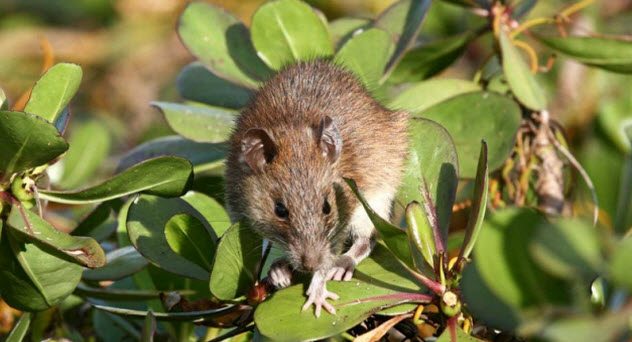
Henderson Island is a remote coral island in the South Pacific. There are no human inhabitants, but the island is home to an abundance of wildlife. Henderson Island contains birds, invertebrates, and plants that do not exist anywhere else in the world. The island also has a serious rat problem.
Polynesian rats were introduced to the island by sailors approximately 800 years ago. Researchers who visit the island today have to be careful with their food packaging because a rat can chew through a tent to reach the snacks inside. Also, the rats regularly eat baby chicks. Approximately 95 percent of chicks that hatch on Henderson Island are eaten by rats within one week. This includes hatchlings of the Henderson petrel, a ground-nesting seabird that is already endangered.
To save the island’s native inhabitants, a plan to get rid of the rats was enacted. In 2011, 80 tons of pellets loaded with rat poison were dropped on the island. The poison seemed to be a success at first, with the number of rats on the island dropping to less than 100.
However, they did not rid the island of every rat and these creatures proliferate very quickly. A female rat can have a litter of six pups every few months. Female pups only take two or three months to mature before they begin having their own litters. As a result, the rat population on Henderson Island is now somewhere between 50,000 and 100,000—the same level before the poisoning.[6]
4 Tonawanda Island Cats
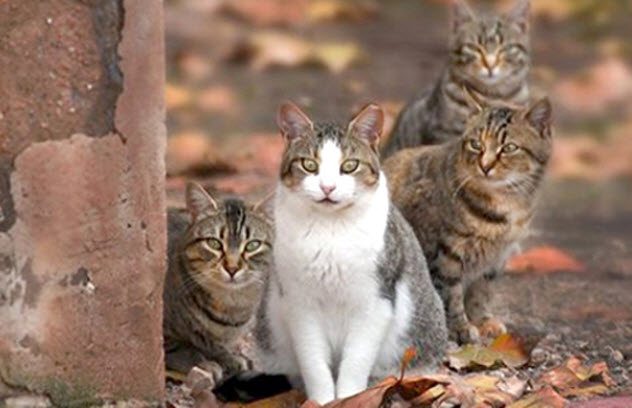
A small New York island on the Niagara River is populated by very few people but is home to a huge mob of stray cats.
A few years ago, Tonawanda Island was swamped with hundreds of sickly, uncared-for cats. While some of the felines may have found their own way onto the island, people had been spotted simply dropping off unwanted cats. The cats left feces everywhere and climbed aboard boats that were docked in the marina. They were a nuisance that gave the island an unpleasant odor.
Danielle Coogan, who lives on the mainland in North Tonawanda, visited the island’s popular restaurant in 2014. Coogan was horrified by the cat situation and decided to do something about it. She started a fundraiser called “Operation Island Cats” that was very successful.
With the money raised, Coogan and a group of volunteers were able to trap, neuter, and vaccinate the cats that lived on the island. Young kittens were put up for adoption, but older cats were returned to their island home. The cats that live on Tonawanda Island now are protected against rabies and common feline diseases and are incapable of producing litters of more strays.[7]
The Tonawanda Island cats were doing quite well, but they experienced a setback last year. The money raised had also been used to put shelters and feeding stations on the island. In spring 2016, the island’s restaurant had a crew working to clean up the aftermath of a fire in the marina. Somehow, the crew ended up bulldozing almost all the cat shelters and feeders.
The owners of the restaurant insist that the damage was an accident. None of the Tonawanda Island cats were harmed, and Coogan was working to raise donations to replace what was destroyed.
3 Okunoshima Rabbits

Okunoshima is a small island located 3 kilometers (2 mi) off the coast of Japan. It is also known as Rabbit Island due to its large population of friendly feral fluff balls.
How rabbits were first introduced to the island is debated. Some people say that the bunnies were left behind when Okunoshima was a secret military site during World War II. The tiny island was removed from all maps of Japan, and the location was used to produce poisonous gas that killed tens of thousands of people. Rabbits were brought in to test the effectiveness of the chemical weapons.
But many experts disagree with this theory. They say that the test rabbits were completely wiped out and none had been left to go free on the island.
A second theory is that a school trip to the island in 1971 may have left a few bunnies behind. With no natural predators on the island, the rabbit population exploded to around 1,000 today.
Many enjoy visiting the island to see the bunnies, but tourism is having a negative impact. People feed the rabbits, which has led to an increase in their population that the island cannot sustain.
Also, rabbits are not naturally a feast-or-famine animal. It messes with their digestive systems when they consume a lot of food on sunny days that attract visitors but are left to scrounge the island on days when the weather deters tourists.[8]
2 Lambay Island Wallabies
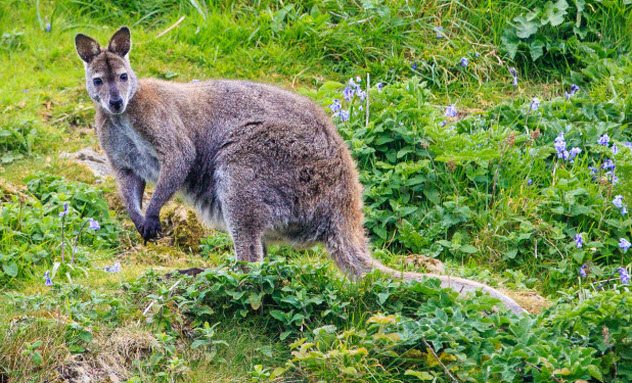
Wallabies, a marsupial native to Australia, are also thriving on an island off the coast of Ireland.
Lambay is a private island that lies 14,500 kilometers (9,000 mi) away from where wallabies are typically found. In Australia, wallabies enjoy warmer weather, while Lambay Island rarely sees temperatures rise above the 15-degree-Celsius (60 °F) range.
But the island does have steep cliffs and rocks that wallabies like, and the Lambay wallabies have adapted to the cooler climate by growing thicker coats of fur. Wallabies are also shy animals, and they seem to appreciate the peace and privacy of this isolated island.
Wallabies were introduced by the island’s owners in the 1950s. Of various species including tortoises and lizards, wallabies were the only non-natives to survive on Lambay Island. In the mid-1980s, the island received seven additional wallabies from a Dublin zoo that could no longer house them.[9]
It was not known how many wallabies were on the island before that, and today’s exact numbers are unavailable because the animals are not tagged. Counting them is difficult due to their tendency to hide, but the Lambay Island wallaby population is estimated to be between 30 and 50.
1 Año Nuevo Island Of Love
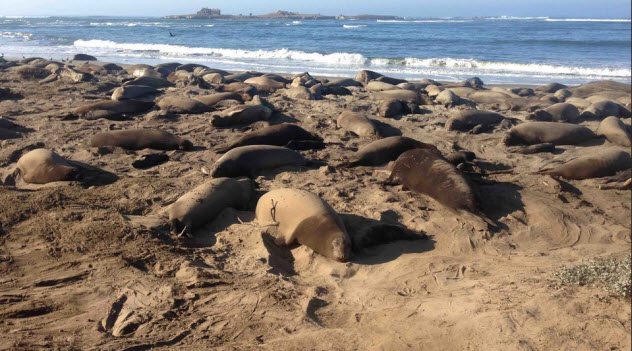
The nine-acre island that lies 0.8 kilometers (0.5 mi) off the coast of northern California is one of the most densely populated animal refuges on Earth. Two hundred years ago, Año Nuevo Island was connected to California’s mainland by a low peninsula. After water levels rose and separated the rocky landmass, the island became a Coast Guard light station from 1872 until 1948.
Today, Año Nuevo is teeming with animals that use it as a breeding site. The island is part of a reserve, and access is granted only for research purposes. Visiting scientists are made aware that their presence is unwelcome. Seagulls screech in their faces and bomb them with guano, and scientists are forced to crawl on their stomachs to avoid triggering a sea lion stampede.
The species that has benefited most from Año Nuevo Island is the northern elephant seal. At one time, the Pacific Ocean teemed with hundreds of thousands of elephant seals. They were hunted for their blubber so aggressively in the 1800s that their numbers had dropped to somewhere between 50 and 100 by 1892.
But Año Nuevo Island became the love shack that brought the northern elephant seals back from the brink of extinction. The first elephant seal was spotted on the island in 1955, and the first pup was born there six years later.
Since then, the area has been used as a popular breeding and birthing site by northern elephant seals, with as many as 2,000 pups born on the island in one year. Today, their growing population is near 160,000.[10]
Read about more fascinating islands on 10 Strange And Mysterious Islands and Top 10 Fascinating Atlantic Islands You Probably Haven’t Heard Of.
